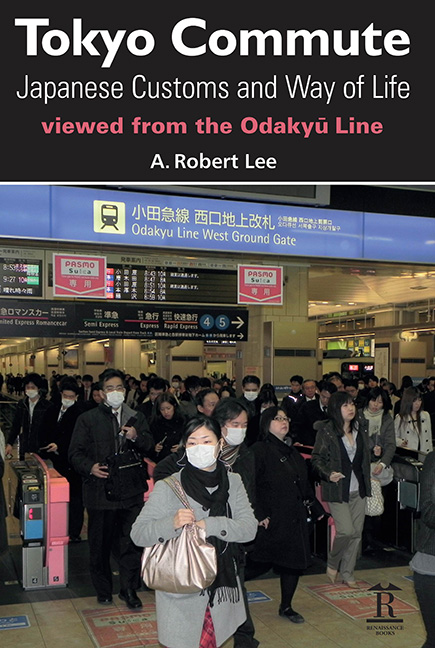Book contents
- Frontmatter
- Dedication
- Acknowledgements
- Contents
- 1 Odakyū-sen
- 2 Shinjuku Station
- 3 Shinjuku
- 4 Mukōgaoka-yūen North
- 5 Mukōgaoka-yūen South
- 6 Mukōgaoka-yūen Platform
- 7 January Monday
- 8 Odakyū Notables
- 9 Odakyū Line Sounds Familiar
- 10 Train Notices
- 11 Odakyū Commercials
- 12 February Tuesday
- 13 Odakyū Keitaispracht
- 14 By-line, Setagaya Line
- 15 March Wednesday
- 16 Odakyū Day-out Sendagi
- 17 Shimo-Kitazawa
- 18 Bicycle!
- 19 Odakyū Bike Interview – Toda-san
- 20 International Interlude via Narita Airport
- 21 Keitai Train Culture
- 22 April Thursday
- 23 Odakyū Tamagawa
- 24 Station Sights
- 25 Odakyū-sen, Yoyogi-Hachiman Eki
- 26 May Friday
- 27 Mukoōgaoka-yūen, Day for Night
- 28 Odakyū Day-out, Hakone
- 29 June Saturday
- 30 Odakyū Commercials
- 31 Odakyū Smokes
- 32 By-line, Nambu Line
- 33 Odakyū Bag Watch
- 34 Seijo Times
- 35 Odakyū Day-out, Yokohama
- 36 July Sunday
- 37 Odakyū Trains of Thought
- 38 Train Signs, Train Sounds
- 39 By-line, Tama Express
- 40 August Monday
- 41 Odakyū Day-out, Chiba
- 42 September Tuesday
- 43 Odakyū Lady-grooming
- 44 Odakyū and Near-Odakyū Women’s Hairday
- 45 Odakyū Evenings-out
- 46 October Wednesday
- 47 Odakyū Day-out, Ibaraki
- 48 Chikan! Odakyū Misbehaviour
- 49 November Thursday
- 50 Odakyū Blues
- 51 Odakyū Men’s Haircut
- 52 Odakyū Day-out, Ō-Sumo
- 53 December Friday
- 54 Odakyū Store
- 55 Odakyū Bookshelf
- 56 Last Train
- Glossary
52 - Odakyū Day-out, Ō-Sumo
Published online by Cambridge University Press: 26 May 2022
- Frontmatter
- Dedication
- Acknowledgements
- Contents
- 1 Odakyū-sen
- 2 Shinjuku Station
- 3 Shinjuku
- 4 Mukōgaoka-yūen North
- 5 Mukōgaoka-yūen South
- 6 Mukōgaoka-yūen Platform
- 7 January Monday
- 8 Odakyū Notables
- 9 Odakyū Line Sounds Familiar
- 10 Train Notices
- 11 Odakyū Commercials
- 12 February Tuesday
- 13 Odakyū Keitaispracht
- 14 By-line, Setagaya Line
- 15 March Wednesday
- 16 Odakyū Day-out Sendagi
- 17 Shimo-Kitazawa
- 18 Bicycle!
- 19 Odakyū Bike Interview – Toda-san
- 20 International Interlude via Narita Airport
- 21 Keitai Train Culture
- 22 April Thursday
- 23 Odakyū Tamagawa
- 24 Station Sights
- 25 Odakyū-sen, Yoyogi-Hachiman Eki
- 26 May Friday
- 27 Mukoōgaoka-yūen, Day for Night
- 28 Odakyū Day-out, Hakone
- 29 June Saturday
- 30 Odakyū Commercials
- 31 Odakyū Smokes
- 32 By-line, Nambu Line
- 33 Odakyū Bag Watch
- 34 Seijo Times
- 35 Odakyū Day-out, Yokohama
- 36 July Sunday
- 37 Odakyū Trains of Thought
- 38 Train Signs, Train Sounds
- 39 By-line, Tama Express
- 40 August Monday
- 41 Odakyū Day-out, Chiba
- 42 September Tuesday
- 43 Odakyū Lady-grooming
- 44 Odakyū and Near-Odakyū Women’s Hairday
- 45 Odakyū Evenings-out
- 46 October Wednesday
- 47 Odakyū Day-out, Ibaraki
- 48 Chikan! Odakyū Misbehaviour
- 49 November Thursday
- 50 Odakyū Blues
- 51 Odakyū Men’s Haircut
- 52 Odakyū Day-out, Ō-Sumo
- 53 December Friday
- 54 Odakyū Store
- 55 Odakyū Bookshelf
- 56 Last Train
- Glossary
Summary
Actually not so much a day-out as a day-in. Fifteen of them, in fact, and likely best to be described as virtual days-out. Sumo by TV, courtesy of NHK (Nippon Hōsō Kyōkai) – Japan Broadcasting Corporation.
For this is Japan's emblematic sport. The rikishi or wrestlers themselves. Huge, stately male bodies, rippled in surface fat but sheer muscle tonnage beneath. Clad in mawashi or belt, black, blue, red, silver and the like. Oiled hair in the form of a top-knot or chonmage. The shinpan or judges invariably former rikishi. The gyoji or umpire in Shinto-style costume and each with his gunbai (originally a war-fan) in hand. The yobidashi, a kind of sumo civil-servant who sweeps the sand smooth, calls out the wrestlers’ names, and wields the hyoshigi or clappers.
A sport steeped in ritual, from the shinto shrine awning with its hanging gohei or white paper zig-zags to the dohyō (the circular fight-ring marked by rice-bale rope). Everything counts – the makunouchi dohyō-iri or ring-entering ceremony with the wrestlers in their apron insignia, the endorsements carried round the ring in flag-parade manner, the purifying salt thrown into the dohyō by each wrestler, the chanted names. The bows. The acts of respect. Shiko or foot stamping at the beginning of a bout, left leg then right leg raised and lowered. All this and more between the yokozuna as Grand Champion performing the unryu-gata dohyō or opening ceremony in his tsuna or white hemp belt through to the kimigayo, the closing national anthem, and the presentation of the massive Emperor's Cup. An NHK interview with the winner of each basho or tournament invariably follows. That is naturally in Japanese, but for myself, and other gaijin, also given in yet more English translation. Imagine an English-language network doing a parallel service – Japanese commentary in a US broadcast on US football or in an Australian broadcast on cricket with translation of arising interviews.
TV sumo in Japanese is all yours throughout the whole of fifteen afternoons. But come 4 p.m. until 6 p.m., and if you switch to the satellite sub-channel of BS2, it is English-language commentary for the rest of the broadcast.
- Type
- Chapter
- Information
- Tokyo CommuteJapanese Customs and Way of Life Viewed from the Odakyū Line, pp. 195 - 199Publisher: Amsterdam University PressPrint publication year: 2011



